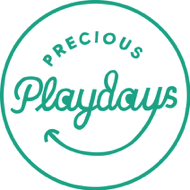The Precious Approach Blog:
You can also follow this blog on Instagram @precious_approach
conceptual Development
🌾 Hands-On Learning in Action! 🌈
In this photo, a child fills a pot with oats, carefully arranging colorful feathers inside. This simple act reflects the image schema of containment—a fundamental way children understand the world. As they explore putting things in and taking them out, they’re not just learning about space and boundaries. They’re also laying the foundation for language! When they physically experience containment, they fully embody words like in and out, making it easier to use them in sentences later on.
At the same time, this moment demonstrates the primary metaphor "arithmetic is object collection"—as the child gathers and arranges materials, they are naturally engaging with early maths concepts like counting, sorting, and grouping.
This is what The Precious Approach is all about—an embodied, enactive way of learning where children don’t just learn concepts, they live them through hands-on exploration.
✨ Every feather, every grain of oats, every little action builds knowledge. ✨
Bees and Flowers
🌼 Learning Through Action & Perception! 🌼
In the Precious Approach, we believe that learning is an active, embodied process—our minds and bodies work together! Through hands-on activities, like creating bees and flowers step by step, children are strengthening their action-perception system—the connection between movement and understanding.
At first, little hands may pile pieces on top of each other without clear form. But as their action and perception systems become more finely tuned, they begin to place each part with intention, creating recognisable bees and flowers! This growing coordination is essential—not just for crafts, but for all learning, from writing to problem-solving.
🌟 Every action builds perception. Every perception shapes action. 🌟
Dynamic Systems
🌀 Learning in Motion! 🎨✍️
This beautiful, messy tray isn’t just fun—it’s a perfect example of how learning is a dynamic system! 🌊
In early childhood education, dynamic systems theory helps us understand how learning happens—not in a straight line, but through movement, change, and interaction. These children aren’t just practicing writing; they’re exploring textures, colours, and motion, all while responding to what’s happening in the moment.
Every swirl of foam, every new colour mixing, every mark they make changes the experience—offering new possibilities, new challenges, and new discoveries. Their learning isn’t given to them; it emerges from their actions and interactions with the materials around them.
When we set up rich, inviting spaces like this, we allow children to experiment, problem-solve, and create in their own way. Learning is always shifting, evolving, and growing—just like them! 💡✨
Enactive Embodied Approach
✨ Learning Through Discovery! ✨
Look at the joy of learning in action! This little explorer just (safely) discovered that magnets stick to the radiator 🧲. But what’s really happening here?
In the Precious Approach, we talk about enactive and embodied learning—where children don’t just absorb information; they actively explore the world with their whole bodies. This child isn’t just “learning about magnets” in an abstract way. He’s feeling the pull, seeing the connection, and moving his body to test his ideas.
His environment is guiding his learning! The radiator wasn’t just a heater today—it became an invitation to explore, an unexpected teacher. This is the magic of body-environment coupling: when children engage with the world, the world responds, offering endless possibilities for curiosity and discovery.
Want to encourage this kind of learning at home? Let your child lead! Provide safe and interesting objects, let them test ideas, and watch how their environment sparks new discoveries. ✨




